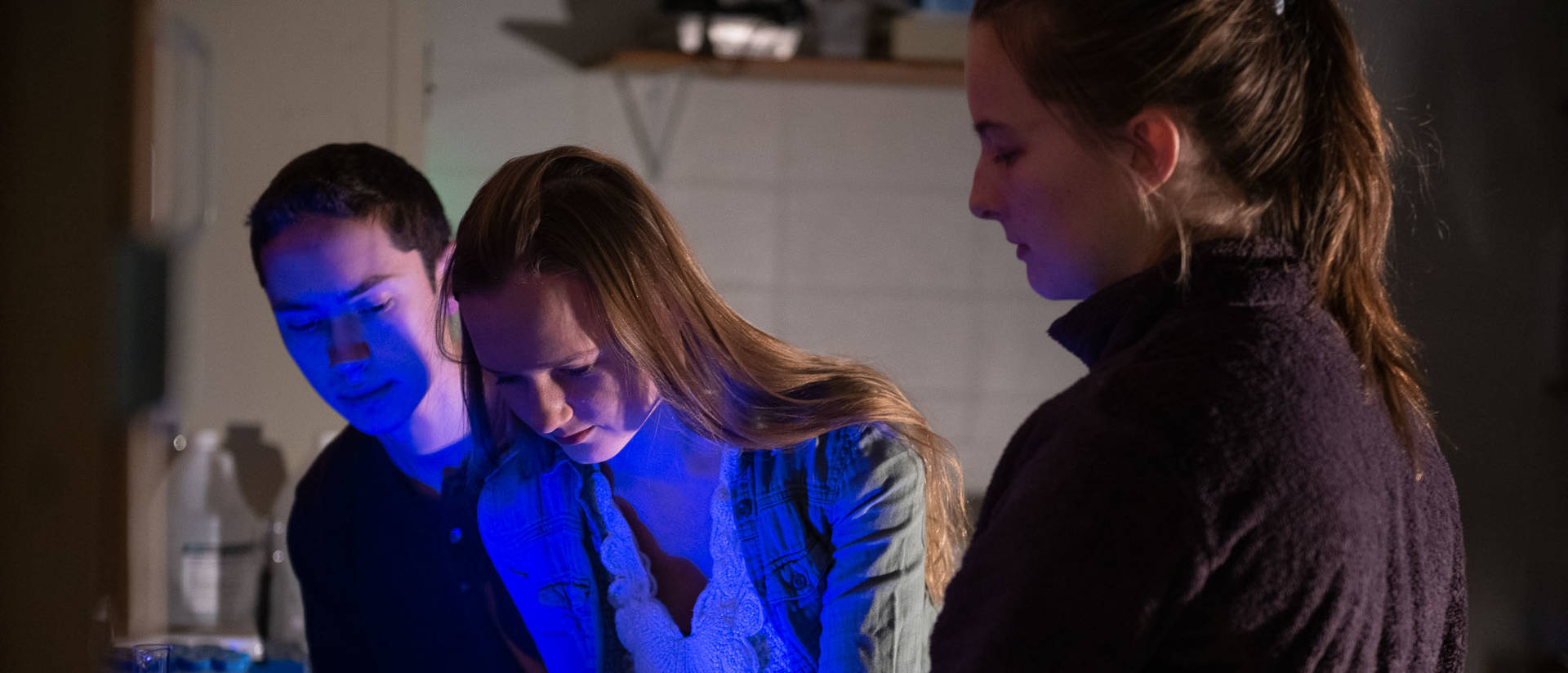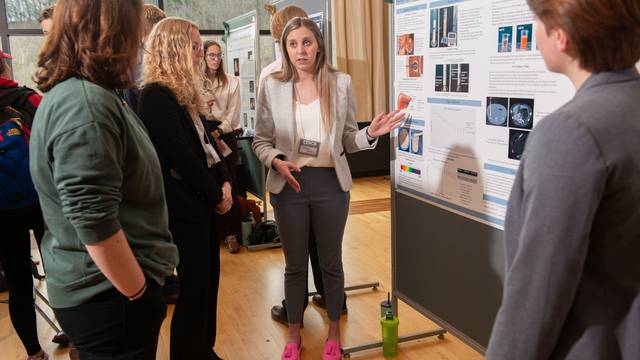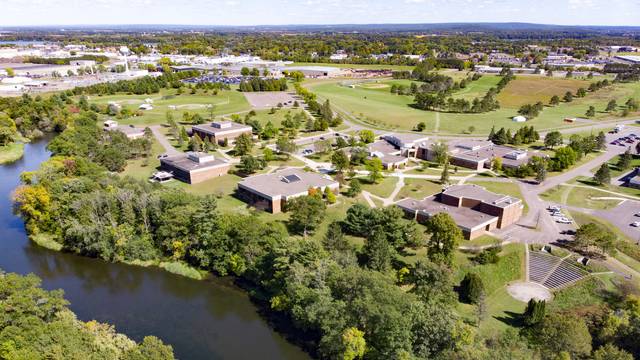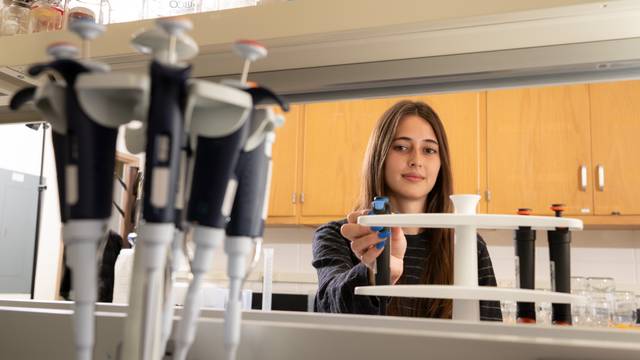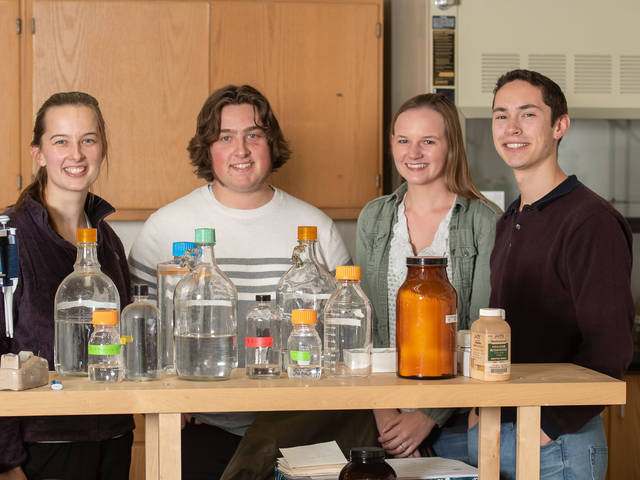
Biology students, from left, Roseanne Nooren, Ryan Pelle, Annika Kueng and Ray Larsen continue to prepare research findings for journal submission by early spring 2020.
With what has become a signature spirit of discovery and exploration, a team of UW-Eau Claire researchers are venturing deep into uncharted waters seeking answers about Wisconsin lake life.
We don't mean that as a figure of speech — we mean that they're literally going deep into lake water for research that's never been done before.

Dr. David Lonzarich
Dr. David Lonzarich, professor of biology, and a team of Blugold biology students are conducting groundbreaking research and spent the summer of 2019 in lakes across Wisconsin. The team intends to publish the first extensive biological study about Wisconsin deep-water mosses, aquatic plant life that survives at depths where little else can.
"These mosses, found in many Wisconsin lakes, are surviving at the extreme edge of life's possibilities," Lonzarich said. "They thrive where water gets about 1% of the light penetration of that at the surface, 30-50 feet down, where almost no other life-forms can survive. This makes them very interesting — biologists are always interested in life on the edge."
But there is more than just their death-defying existence that makes deep-water moss interesting and worthy of further examination, according to Lonzarich.
A variety of these plants exist in some of the clearest lakes across the state at these depths, but they are totally absent in other very similar lakes, begging the questions about what makes these deep waters different.
"In the way we describe lake water, clarity equals quality, so why are these mosses not found in all lakes with high water quality? Why are they only found in some of these lakes?" Lonzarich asked, as he also wondered what impact the mosses have on other lake life.
This quickly became the central set of questions that he and the student team set out to answer: Where do we find deep-water moss and what do those lakes have in common?
Truly pioneering research in the state
Lonzarich's research team of four students quickly discovered just how little is known about these deep-water mosses in the state. One supposition of the team, Lonzarich says, is that it might reflect a history of land use surrounding certain lakes that has somehow degraded the water quality in ways that won't allow for these mosses to grow.
"We have assumed that any degradation that occurred has self-corrected because the water eventually clears," Lonzarich said. "But maybe it's much more complex than that — there could be lasting impact that we can't see. There may be invisible legacies of past land use that have important implications for lake ecology."
In terms of standard research process, the team hit a hurdle right out of the gate. Step one in most research of this nature is to gather and review the existing publications on the topic, a "review of the literature" as it's called. But what do you when there is virtually no research out there?
You start from scratch, as this team is doing.
"There has been one published paper that we could find, a study completed in Vilas County in the southern part of the state, back in 1938," Lonzarich said. "This was the only study in which mosses were previously documented in any way, and it was simply documenting that they existed in these locations."
With this dearth of research on which to base any hypotheses, the team's intent to publish a peer-reviewed paper took on new gravity, elevating it to a new level of importance.
Student research team member Ray Larsen, a senior from Rochester, Minnesota, explains the value of what they were setting out to discover, and how it could make an impact.
"This project is the first comprehensive survey of deep-water mosses in northwestern Wisconsin," said Larsen, a psychology major and biology minor. "We are on the frontier of this scientific topic, and can make discoveries that could help to inform lake associations, residents and businesses about the overall health of the lake water ecosystems they live and work around."
In a state with more than 15,000 inland lakes, any measures taken to better and more fully understand lake ecology become highly valued.
Roseanne Nooren, a junior biochemistry/molecular biology major from Appleton, elaborates on just how widely the impact of these plants could and should be felt by Wisconsin residents and tourists.
"It would be different if people could see these plants on a day-to-day basis, but we cannot, so why care, you might ask," Noreen said. "Sometimes the most important parts of our ecosystem are hidden from us; this research will hopefully help to discover how important deep-water moss is to the environment and healthy ecosystems of our lakes."
Supplementing state knowledge
UW-Extension researcher Paul Skawinski is based at UW-Stevens Point and has worked closely with Department of Natural Resources scientists in his work studying aquatic plant life. He's familiar with Lonzarich's project and helps to place its importance within the known factors of these unique plants.
"DNR crews and other groups conducting aquatic plant surveys do record when they find aquatic moss, but there is a poor understanding of how many different species we have, and what their habitat requirements might be," Skawinski said. "The presence or absence of these mosses may be indicators of declining water quality or lake health. They may provide critical habitat to support invertebrates, which ultimately become food for fishes, frogs, turtles, birds and other larger animals. Knowing the characteristics of deep-water moss communities could lead to a better holistic understanding of lake ecology."
A summer of hard work
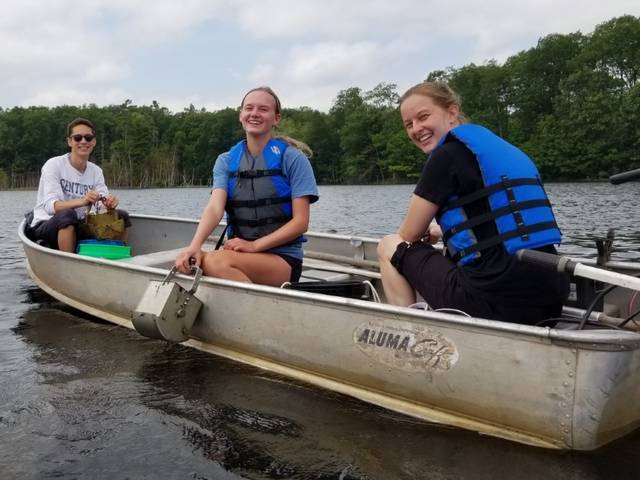
Research team members Ray Larsen, Annika Kueng and Roseanne Nooren collecting deep water moss from Spider Lake in northwestern Wisconsin. Ryan Pelle (not pictured) conducted depth measurements from a nearby kayak, key data in the research.
Lonzarich's student team understood that the project would involve fieldwork and a need to retrieve moss from very deep water. They experienced a new appreciation for grueling physical labor outdoors in the elements, after using fairly primitive manual dredging equipment out on several lakes each day. In fact, just getting onto the lakes was a separate challenge at times, as Ryan Pelle described.
"Dr. Lonzarich made us aware that it would be physically demanding, and it really was. One lake that we wanted to get to required us to haul in a 12-14-foot aluminum boat through the woods, not on a path — that was tough. It was a good 400-500 yards, except on the way back to the vehicles we got lost, so it was a longer carry. I earned dessert that day," Pelle joked.
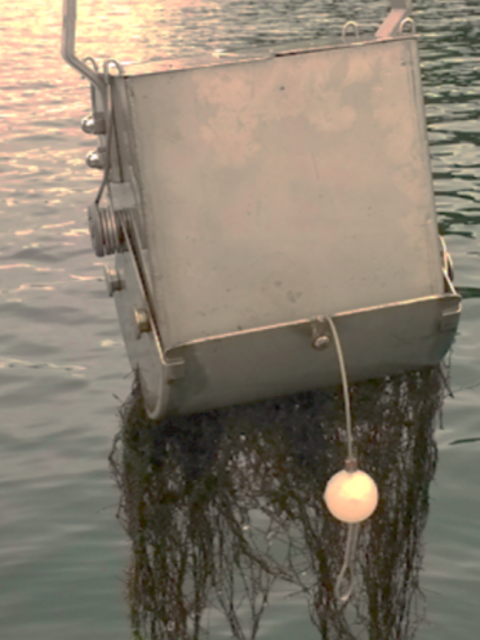
Students employed a heavy dredge system to manually harvest deep-water moss samples from depths of 30-50 feet in area lakes.
As for the moss collection, dropping the dredges into deep water was slow and painstaking. Using maps to find the deepest parts of the water, the team developed a system of who drove the boat, who paddled by kayak collecting water samples and who operated the GoPro camera to dive to the bottom.
"The water at the depths we were reaching is as cold as the deep ocean, even with a wetsuit. It's just not doable to dive," said Lonzarich about the need to make use of a dredge system to reach the depths.
"Working on up to three lakes per day and doing the hard manual work of the dredges was frustrating at times, but we were all in it together," Larsen said. "Being out in nature was a treat, seeing loons, deer, bald eagles — I wouldn't have wanted to spend the summer any other way."
Where the project stands today
While this research into deep-water moss overall might be in preliminary stages, Lonzarich and his students still plan to submit a paper for publication, and are moving closer to that goal each week.
"The students began working on the manuscript in late summer and a draft is pretty far along," Lonzarich said. "We are in the data analysis phase, and our goal is to have a paper sent out to a journal by the end of January."
As their lab work, data analysis and draft-writing phases of this project continue, so too does the accumulation of skills and valuable experience each of these student researchers will take from the work.
Annika Kueng, a senior ecology and environmental biology major from Champlin, Minnesota, was new to this type of collaborative research, but had done some fieldwork during an internship with the Coastal Marine Education and Research Academy.
"This experience gave me hands-on practice in the scientific process in a way that I could not have received in a formal course," Kueng said. "I found out that I actually enjoy fieldwork and it solidified my ambition to pursue ecological fields as a career."
Coming to this work with proper preparation gave these students an advantage in the field that was much appreciated by Larsen, who felt that his courses had prepared him well for both the field and lab work demands of this project.
"Being thoroughly prepared by our faculty members gave me the confidence to conduct this research and compile it into a peer-reviewed publication," Larsen said. "Being able to work on a project and have autonomy to go different directions in data collection is an excellent way to learn the scientific method."
The mentoring from Lonzarich has empowered these students to grow as independent scientists in a way that allowed Pelle, a biology major from Rice Lake, to see it all like true collaboration.
"Dr. Lonzarich has made it our project; he is there as a resource," Pelle explained. "He doesn’t tell us answers, and he asks us to help him understand some things. Both parties recognize that each knows something the other doesn’t, and a great back-and-forth conversation can develop."
The academic and personal growth that comes from collaborative research is an aspect of teaching that propels Lonzarich to keep finding projects with which to involve his students.
"Classroom experiences rarely can replicate the unique features of research, which include students taking on truly novel questions, overcoming challenges associated with data collection and analysis, and in some cases, being pushed to their limits, physically."
Next steps
As is the case with many collaborative student-faculty research projects, this study will continue into the foreseeable future, as this team and subsequent student teams graduate.
In developing a long-term strategy for continuing this work, Lonzarich has laid out a series of goals.
"At this moment, I have three goals," he said. "First will be to use a genetic approach to answer questions about the origins of deep-water moss communities (it is conceivable that some populations might have settled in lakes thousands of years ago, at the end of the most recent Ice Age). Next, we will set out to answer the question of what role do deep-water mosses play in the ecology of lakes. Lastly, we will explore the factors that determine species composition of deep-water moss communities in lakes."
Lest we think that research discovery ever officially ends, Lonzarich was quick to follow up with an addendum.
"More goals are likely to materialize as we learn more about these plants," he added.
Luckily there will never be a shortage of eager Blugolds wanting to know more, discover more and continue the search for answers about these mysterious plants at the bottom of Wisconsin lakes.
Top photo caption: UW-Eau Claire students (from left) Ray Larsen, Annika Kueng and Roseanne Nooren use blue (UVB) light to view DNA from moss samples that has been separated by electrophoresis through an aragrose gel. The gel is stained so that the UVB light causes the DNA and dye to fluoresce and become visible.
